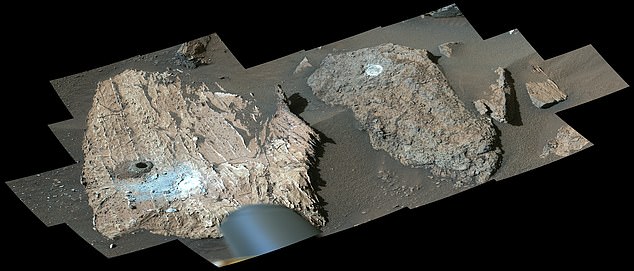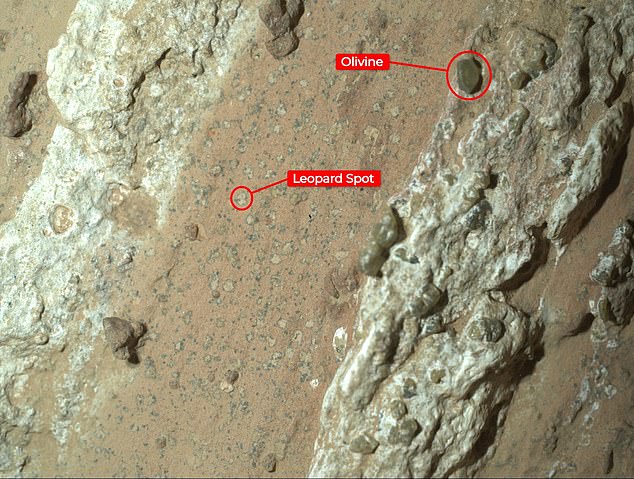NASA Discovers First ‘Possible’ Signs of Life on Mars
NASA’s Mars rover has discovered the first ‘possible’ signs of ancient life on the Red Planet.
The agency’s Perseverance rover discovered what it described as an arrowhead-shaped rock with what appeared to be veins running through it.
Scientists found that it contained chemical signatures and structures formed by microbial life billions of years ago.
The rover sent the images back to Earth, revealing crystalline solids left over from water flowing across the surface, and a reddish area that organic compounds and an energy source for ‘what could have been microbial life.’
The rock, which measures 97 by 60 centimeters, is named after the Cheyava Falls waterfall in the Grand Canyon.
Perseverance discovered a vein-filled, arrowhead-shaped rock with chemical signatures and structures formed by microbial life billions of years ago
Perseverance Project Scientist Ken Farley said: “Cheyava Falls is the most enigmatic, complex and potentially important rock Perseverance has investigated to date.
‘On the one hand, we have our first convincing detection of organic material, striking colorful spots that indicate chemical reactions that microbial life could use as an energy source, and clear evidence that water – essential for life – once flowed through the rocks.
‘On the other hand, we have not been able to determine exactly how the rock was formed and to what extent nearby rocks heated the Cheyava Falls and thus contributed to these phenomena.’
Perseverance collected the rock on July 21 while exploring the northern rim of Neretva Vallis, an ancient river valley carved 3.7 billion years ago by water flowing into the Jezero crater, a lake.
The team observed the vein-like structures everywhere and discovered that they were white calcium sulfate structures.
The crystalline solids on the Martian surface are deposits of hard water, left behind by ancient groundwater that flowed through the now dusty landscape.
Between these veins were bands of material with a reddish color, indicating the presence of hematite, one of the minerals that gives Mars its characteristic rusty color.

Perseverance collected the rock on July 21 while exploring the northern rim of Neretva Vallis, an ancient river valley carved 3.7 billion years ago by water flowing into the Jezero crater, a lake

The rover took a core sample from the rock (where the dark hole on the left is located) to investigate
A closer look at the reddish area revealed “dozens of irregularly shaped, millimeter-sized, off-white spots, each surrounded by black material, similar to leopard spots,” NASA said.
Perseverance used an X-ray machine to analyze the spots and determined that the black halos contained iron and phosphate.
David Flannery, an astrobiologist and member of the Perseverance science team, said: “These spots are a big surprise.
‘On Earth, these kinds of features in rocks are often associated with fossil remains of microbes living in the subsurface.’
The Perseverance’s science team hasn’t yet reached a definitive conclusion, but is considering several scenarios about what the features could be.
One of them is that The Cheyava Falls were originally deposited as mud containing organic matter, which eventually became stuck in the rocks.
Later, fluid flowed through cracks in the rock for a second time, creating mineral deposits that formed the large white calcium sulfate veins we see today and which led to the spots.

The leopard spots could be signs of ancient life. The olivine could be related to rocks formed further along the river valley edge, possibly produced by crystallization of magma
“While the organic material and the leopard spots are of great interest, they are not the only aspects of the Cheyava Falls rocks that are puzzling the science team,” NASA said.
‘When they discovered that these veins were filled with millimeter-sized crystals of olivine, a mineral that forms from magma.
The olivine could be related to rocks formed further along the river valley margin, possibly created by crystallization of magma.
‘If so, the team needs to answer another question: Could the olivine and sulfate have been deposited in the rocks at unlivable high temperatures, causing an abiotic chemical reaction that led to the leopard spots?’
The scientific team now hopes to return the Cheyava Falls sample to Earth so it can be studied with the powerful instruments available in laboratories.
